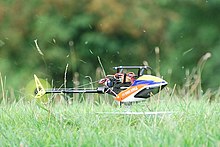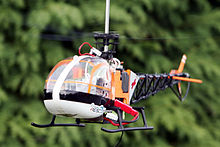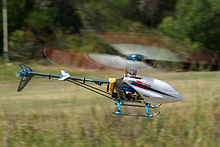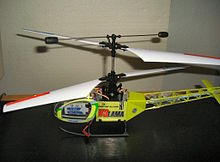Rc Radio Transmitter Reviews Fixed Wing Versus Copter

Electric Trex 250 micro heli flying inverted

Electric-powered Venom Air Corps Bounding main Rescue


Electrical-powered E-flite Bract 400 3D

Electric-powered Syma S107

This Heli-Max Axe Micro CX model helicopter is an example of a micro-sized coaxial model. Notation the size comparison with the cellular phone at right.
A radio-controlled helicopter (besides RC helicopter) is model aircraft which is distinct from a RC airplane because of the differences in construction, aerodynamics, and flight training. Several basic designs of RC helicopters be, of which some (such equally those with collective pitch control) are more than maneuverable than others. The more maneuverable designs are often harder to fly, but benefit from greater aerobatic capabilities.[one]
Flight controls allow pilots to command the commonage (or throttle, on fixed pitch helicopters), the cyclic controls (pitch and curlicue), and the tail rotor (yaw).[2] Controlling these in unison enables the helicopter to perform the aforementioned maneuvers as total-sized helicopters, such as hovering and backwards flight, and many other maneuvers that full-sized helicopters cannot, such as inverted flight (where commonage pitch command provides negative blade pitch to hold heli up inverted, and pitch/yaw controls must exist reversed by airplane pilot).[3]
The various helicopter controls are effected by ways of pocket-size servo motors, commonly known as servos. A solid-state gyroscope sensor is typically used on the tail rotor (yaw) command to counter current of air- and torque-reaction-induced tail movement.[iv] Near newer helicopters have gyro-stabilization on the other 2 axis of rotation (pitch and whorl) as well. Such 3-axis gyro is typically chosen a flybarless controller, so-called considering it eliminates the need for a mechanical flybar.[five]
The engines typically used to exist methanol-powered two-stroke motors, but electric brushless motors combined with a high-performance lithium polymer battery (LiPo) are now more common and provide improved efficiency, operation, and lifespan compared to brushed motors, while decreasing prices bring them within accomplish of hobbyists. Gasoline and jet turbine engines are as well used.[6]
Just like full sized helicopters, model helicopter rotors turn at loftier speeds and can cause astringent injuries. Several deaths have occurred as recently as 2013.
Types of R/C helicopters [edit]
Common power sources of remote control helicopters are glow fuel (also called nitro fuel, nitromethane-methanol), electric batteries, gasoline (petrol) and turbine engines. For the starting time forty years, glow fuel helicopters were the most common type produced. However, in the last ten years, electric powered helicopters have matured to a indicate where ability and flight times are amend, but typically non equally long as glow fuel helicopters.
In that location accept been 2 chief types of systems to control the chief rotors, mechanical mixing and electronic cyclic/collective pitch mixing (eCCPM). About earlier helicopters used mechanical mixing. Today, nearly all R/C helicopter use eCCPM.[7]
Practical electrical helicopters are a recent evolution but have rapidly developed and get more common, overtaking glow fuel helicopters in common use. Turbine helicopters are besides increasing in popularity, although the loftier cost puts them out of accomplish of most people.
Internal Combustion (Nitro, Gas) [edit]
The first RC helicopters take been powered by combustion engines (Glow fuel, or nitro, too as gas, or gasoline as the fuel source). Original helicopter "classes" were based on the engine size. For instance, a helicopter with a 0.30 cu in (iv.9 cmiii) engine was a 30 course and a helicopter with a 0.ninety cu in (fourteen.vii cm3) engine was referred to as a 90 course helicopter. The bigger and more powerful the engine, the larger the master rotor blade that it tin plough and hence the bigger the shipping overall. Typical flight time for nitro helicopters is seven–15 minutes depending on the engine size and tuning.
Electric [edit]

The 252 km/h fast electric helicopter TDR
2 pocket-sized electric helicopters emerged in the mid-1990s. These were the Kalt Whisper and the Kyosho EP Concept, flying on 7–8 × 1.ii Ah NiCad batteries with brushed motors. Still, the 540-sized brushed-motors were on the limit of current draw, often 20–25 amps on the more powerful motors, hence brush and commutator problems were common.
Contempo advancements in bombardment engineering science are making electrical flying more feasible in terms of flying time. Lithium polymer (LiPo) batteries are able to provide the high electric current required for high performance aerobatics while still remaining very light. Typical flight times are 4–12 minutes depending on the flying style and battery capacity.
In the past electric helicopters were used mainly indoors due to the small size and lack of fumes. Larger electrical helicopters suitable for outdoor flight and avant-garde aerobatics accept become a reality over the last few years and accept become very pop. Their quietness has made them very popular for flying sites close to residential areas and in places such as Germany where at that place are strict dissonance restrictions. Nitro helicopters accept also been converted to electric ability by commercial and homemade kits.
The smallest remote-controlled product model helicopter made (Guinness World Records 2014) is the Silverlit Nano Falcon XS sold at many toy stores (although this is infrared controlled, not radio), electronics stores and cyberspace stores, costing about $30 (£28). The side by side smallest is the Nano Falcon, which previously held the record for the smallest rc helicopter.
Several models are in contention for the championship of the smallest not-production remote-controlled helicopter, including the Pixelito family of micro helicopters, the Proxflyer family, and the Micro flying robot.
Coaxial [edit]

A Lama V3 model helicopter, with a simplified coaxial rotor system.
A contempo innovation is that of coaxial electric helicopters. The system'due south unproblematic direction control and liberty from torque induced yaw have, in recent years, fabricated it a good candidate on small models for beginner and/or indoor use. Models of this type, as in the example of a full-calibration helicopter, eliminate rotational torque and can have extremely quick control response, both of which are very pronounced in a CCPM model. Nearly cheaper models do not take a swashplate, but instead employ a third rotor on the tail to provide pitch control. These helicopters have no coil command and have limited mobility.
While a coaxial model is very stable and can exist flown indoors fifty-fifty in tight quarters, such a helicopter has limited frontwards speed, especially outdoors. Most models are fixed-pitch, i.e. the collective pitch of the blades cannot be controlled, plus the circadian control is only practical to the lower rotor. Compensating for even the slightest breeze causes the model to climb rather than to wing forward even with full application of cyclic. More avant-garde coaxial constructions with 2 swash plates and/or pitch command (common for full-scale coaxial helicopters like Kamovs) have been realized as models in individual projects but have not seen the mass market place as of 2014[update].
Multirotor model helicopters [edit]

More recently, multirotor designs have go popular in both the RC hobby and unmanned aeriform vehicle (UAV) research. These vehicles use an electronic control organisation and electronic sensors to stabilize the aircraft. Multirotors are generally more than affordable, easier to construct, and simpler to operate than RC helicopters. This made multirotor aircraft an appealing platform for amateur model aircraft projects and aerial photography.[9] [x]
Size classes [edit]
Nitro RC helicopters are categorised under the following classes:
- xxx size : Engine 0.3 cubic inch, Principal Blades 550-600mm
- 50 size : Engine 0.five cubic inch, Chief Blades 600-620mm
- 60 size : Engine 0.vi cubic inch
- ninety size : Engine 0.9 cubic inch, Main Blades 690-710mm
Modern RC helicopters are generally classed by the length of the main blades (with few exceptions). Common classes are:
- Micro (nether 200mm principal blades)
- Mini (240-420mm blades) - classically chosen 300-450.
- 500 (425-500mm)
- 600 (600mm)
- 700 (standard contest size)
- 800
Radio gear [edit]
Transmitter [edit]
RC helicopters generally require between 3 and seven channels for control (although micro helicopters that utilize a 2-channel infrared control system also exist). Small fixed-pitch helicopters use a 4-channel radio (throttle, elevator, aileron, rudder); while commonage-pitch models need a minimum of 5 channels (throttle, commonage pitch, elevator, aileron, and rudder). 6th aqueduct is ofttimes used for gyro gain. seventh aqueduct commonly used for engine governor control for fuel powered models. Because of the normal interaction of the various control mechanisms, avant-garde radios include adjustable mixing functions, such as throttle/collective and throttle/rudder.[11] Radio prices vary from $50–$3,000 USD.
Early radio controls systems used amplitude modulation (AM) to transmit their signals. In the late '70s, frequency modulation (FM) became more commonplace.
Spread spectrum [edit]

Spektrum DX6i vi-channel spread spectrum computerized aircraft radio which may be used for both helicopters and fixed-wing models
Starting with the Spektrum DX6 park flyer transmitter system in 2006, RC flying began the deviation from various lower frequencies which were subject to interference and were less reliable than the new spread spectrum protocols. Systems such as Spektrum and JR utilize the DSM2 and later on, DSMX direct-sequence spread spectrum (DSSS) method, where they transmit on a pair of stock-still channels chosen when the radio and receiver are turned on. Any subsequent systems would avoid using these channels and continue searching for another unused pair of channels.
Systems such equally frequency-hopping spread spectrum (FHSS) used past Futaba use frequency hopping on the 2.4 GHz band instead of the various frequencies in the lower MHz ranges. The advantage is that radios are no longer using a fixed frequency during flying, mitigating the risk of interference on that fixed frequency.
With either method many radios can exist transmitting at once without interfering with each other. The Futaba systems change frequency approximately every two milliseconds, so even if ii transmitters are using the same channel they are not doing so for long. The pilot will not observe any aberrant beliefs of the model in the 1/500th of a 2nd that they are interfering. This gives one the advantage of turning on a transmitter without regard to channels currently in use by other pilots' radios.
One downside to 2.iv GHz is that precautions must be taken during installation since certain materials such as carbon cobweb tin can mask the signal. In some cases, satellite receivers with secondary antennas demand to be used to maintain better line-of-sight with the transmitter radio. Another drawback is that a ii.iv GHz standard has yet to evolve so that receivers and transmitters tin can be mixed regardless of their respective manufacturer.
Controls [edit]
Learning to fly a collective pitch RC helicopter takes time and practice. Many modelers bring together a order so they tin can exist instructed by experienced RC pilots, or follow on-line guides.[12]
RC Helicopters usually take at least four controls: roll - circadian pitch, elevator (fore-aft cyclic pitch), rudder (yaw) and pitch/throttle (collective pitch/power).[3] For simple flight, the radio is unremarkably configured such that pitch is around −i degree at 0% throttle stick, and somewhere around 10 degrees at 100% throttle stick. Information technology is besides necessary to attune the throttle in conjunction with the pitch and then that the model maintains a constant rotor speed. This is beneficial for consistent and smooth flight functioning.
If aerobatic '3D' functioning is desired, and so automated throttle, or idle up, manner of flight is used. In this manner, the collective pitch ranges from its negative limit at 0% throttle stick input, up to its positive limit at 100% throttle stick. The throttle, on the other hand, is modulated automatically to maintain a constant rotor speed and is usually at its lowest value when the throttle stick is centered and the pitch is 0. This mode allows the rotor to produce a thrust upwards (past using negative pitch) which, when the model is inverted, allows sustained inverted flying. Normally a more than advanced computer radio is used for this kind of flight, which allows customization of the throttle-collective mix.
The cyclic and yaw controls are not by definition different in these two modes, though 3D pilots may configure their models to be much more responsive.
Construction [edit]

Radio controlled model of a Bong 222 helicopter with pilot.
Construction is typically of plastic, glass-reinforced plastic, aluminium or carbon fiber. Rotor blades are typically made of wood, fiberglass or carbon fiber. Models are typically purchased in kit grade from one of near a dozen pop manufacturers and take 5 to twenty hours to completely assemble.
These model helicopters comprise many moving parts coordinating to those on full-size helicopters, from the swashplate to rotor and everything in between.
The construction of helicopters has to be more precise than for fixed-fly model aircraft, because helicopters are susceptible to fifty-fifty the smallest of vibrations, which can cause problems when the helicopter is in flight.
Additionally, the small size and low weight of R/C helicopters and their components means that control inputs, peculiarly cyclic (pitch and roll) can have a very fast response, and cause a rotation rate much faster than the equivalent input might produce on a full-size aircraft. This quick response can make the model unnecessarily difficult to fly. For this reason, near model helicopters either have a flybar or electronic stabilizing equipment.
To reduce mechanical complication and increase precision of the control of the swashplate some model helicopters use cyclic/collective pitch mixing.
Competition [edit]
Aerobatic helicopter flight has historically followed the Fédération Aéronautique Internationale rules, which for helicopters are labelled F3C. These include a predetermined routine of hovering and aerobatics.
An advanced class of RC helicopter flying is called 3D. During 3D flying, helicopters perform advanced aerobatics, sometimes in a freestyle form, or in a predetermined gear up of moves drawn upwards by the organisers of the contest. In that location are a number of 3D competitions around the earth, ii of the all-time-known beingness the 3D Masters in the UK and the extreme Flight Title (XFC) in the U.s..
In 2008, the Fédération Aéronautique Internationale introduced the form of F3N every bit a provisional class for international 3D competition and in 2010 at the CIAM Plenary coming together, F3N gained formal approval for competition constructive 1 January 2011.
F3N rules are designed to provide a consistent standard of judging throughout the World and give countries the take chances to field a Team at a World title hosted every two years. F3N is conducted in a similar manner as 3D Masters and 3DX with iii round types made up of Set Manoeuvres, Freestyle Flight and Flight to Music.
Commercial applications [edit]
While some companies brand utilise of RC multicopters for low distance aeriform photography, filming, policing, and remote ascertainment or inspection, RC helicopters are not normally used for commercial purposes. Ane notable exception is crop spraying with large RC helicopters such equally the Yamaha R-MAX.
United states of america Federal Aviation Administration regulations from 2006 grounding all commercial RC model and unmanned aerial vehicle (UAV) flights have been upgraded to crave formal FAA certification before being permitted to wing at whatsoever altitude in the The states.[thirteen] All commercial owners must register with FAA, as well every bit pass a noesis test. Non-commercial operators must register simply if the models they fly weigh more than 0.55 pounds (250g).
Decision-making methods [edit]
Remote Control:
Most RC helicopters make use of a handheld remote device with an antenna that sends signals to the helicopter'due south IR receiver. The remote is generally a range from 3-five aqueduct RC Helicopter and can provide the methods of moving in the air depending on the number of channels that came with the remote command. There are 2 unlike sticks. On the left is the stick to change the altitude. Sometimes the stick can stay wherever the finger places it or it has to exist held since underneath is a spring causing it to movement back to its neutral position once released past the finger. The correct stick is for moving the helicopter around in the air in different directions. On the controller is also a trimmer setting which helps in keeping the helicopter focused in i direction. Mostly low grade RC Helicopters volition include a charging cable within the remote with a green light indicating that the battery is in accuse.
Phone and tablet control:
With the influence of touch screen devices more often than not phones and tablets many RC Helicopters can exist controlled from any Apple or Android device. On the operating organization shop is an app specifically for that particular RC Helicopter. The controls are virtually identical to those on a physically used remote control when using virtual remote control. The device is not included with the helicopter ready but the box does come with an radio chip to insert into the headset slot of any smartphone or tablet
Safety [edit]
'Model' helicopters can be dangerous. Prophylactic precautions, proper maintenance, and an agreement of the mechanics and flight characteristics of the models are necessary to prevent accidents.[14] Modelers who fly at sanctioned sites are required to follow prophylactic rules designated by national model aircraft organizations. In the Usa, the Academy of Model Aeronautics (AMA) publishes and updates condom rules for all model shipping operations, including fixed and rotary fly models.[fifteen] In 2014, several organizations with interest in unmanned aircraft systems in partnership with the Federal Aviation Administration launched a new educational campaign to promote safe and responsible flying and provide guidance for hobbyists and commercial users.[16]
Deaths [edit]
In July 2013, a 41-yr-sometime Swiss human was plant expressionless in Mauensee nearly his model helicopter. He had "severe head and arm injuries".[17]
A September 2013 incident in New York Urban center highlighted the possible dangers of remote controlled model helicopters when a 19-twelvemonth-old enthusiast, who was very experienced in flying remote controlled helicopters, died later on 1 of his helicopters' blades struck his caput.[18]
Miniature helicopters [edit]
Miniature helicopters are remotely controlled helicopters with a weight ranging from but a few grams to one hundred grams. Nearly in production are toys aimed at hobbyists and enthusiasts. In addition, there are many companies making prototypes for military and security applications. Miniature helicopters are popular demonstrations for the latest technologies in miniaturization.[nineteen]
Examples of these types of miniaturized models are the E-Flite Blade CX and CX2 and the Picoo Z, a popular consumer model. Along with the Proxflyer, a prototype and basis for many product models. One terminal example is a one-off prototype and technology sit-in particular that was adult by Seiko Epson, and demonstrated at the International Robot Exhibition in Tokyo is the Seiko Epson Micro flight robot.
See also [edit]
- IRCHA
References [edit]
- ^ "Electrical Helicopters". Retrieved 28 October 2014.
- ^ "Operating R/C Radio Controls". Retrieved 28 Oct 2014.
- ^ a b "RC Helicopter Controls". Retrieved 28 Oct 2014.
- ^ "Agreement RC Heli Gyros". Retrieved 28 Oct 2014.
- ^ "Flybarless Controller". Retrieved 28 Oct 2014.
- ^ "Buyers Guide". Intermediate/Advanced Outdoor Models. RCMods. Archived from the original on 9 July 2013. Retrieved 29 May 2013.
- ^ Iszech, Pavel (20 January 2010). "RC Helicopters Archieven". DroneVinder (in Dutch). Retrieved ii January 2017.
- ^ "ALMA Filmed with Hexacopter". ESO Announcement . Retrieved 6 September 2013.
- ^ "How-To: Quadrocopter based on Arduino - Make". 13 Jan 2010.
- ^ "FrontPage - UAVP-NG - The Open Source Side by side Generation Multicopter".
- ^ "Difference Between 3,4, and 7 Channel Controllers". Retrieved 23 January 2015.
- ^ "Are RC helicopters hard to fly?". Retrieved 28 Oct 2014.
- ^ "Warning: FAA Says U.s.a. Airspace Is Closed To ALL Commercial". Photography For Existent Estate. 2012-01-24. Retrieved 2013-12-05 .
- ^ C.Hatch (2013-10-13). "Safety Precautions With Remote Command Toys". WhizToy. Archived from the original on 2013-xi-09. Retrieved 2013-12-07 .
- ^ "Academy of Model Aeronautics National Model Airc raft Safety Code" (PDF). Academy of Model Helmsmanship. Retrieved 27 October 2014.
- ^ "Know Before You lot Fly". 2014. Retrieved 23 December 2014.
- ^ Everett Balmores (2013-07-11). "Tragic news from Switzerland involving a model helicopter". RC Heli Resources. Retrieved 2013-12-05 .
- ^ J. David Goodman (September 5, 2013). "Remote-Controlled Model Helicopter Fatally Strikes Its Operator". New York Times . Retrieved 2013-12-05 .
- ^ "Epson Corporate: Newsroom". Epson.co.jp. Retrieved 2013-12-05 .
Source: https://en.wikipedia.org/wiki/Radio-controlled_helicopter
0 Response to "Rc Radio Transmitter Reviews Fixed Wing Versus Copter"
Post a Comment